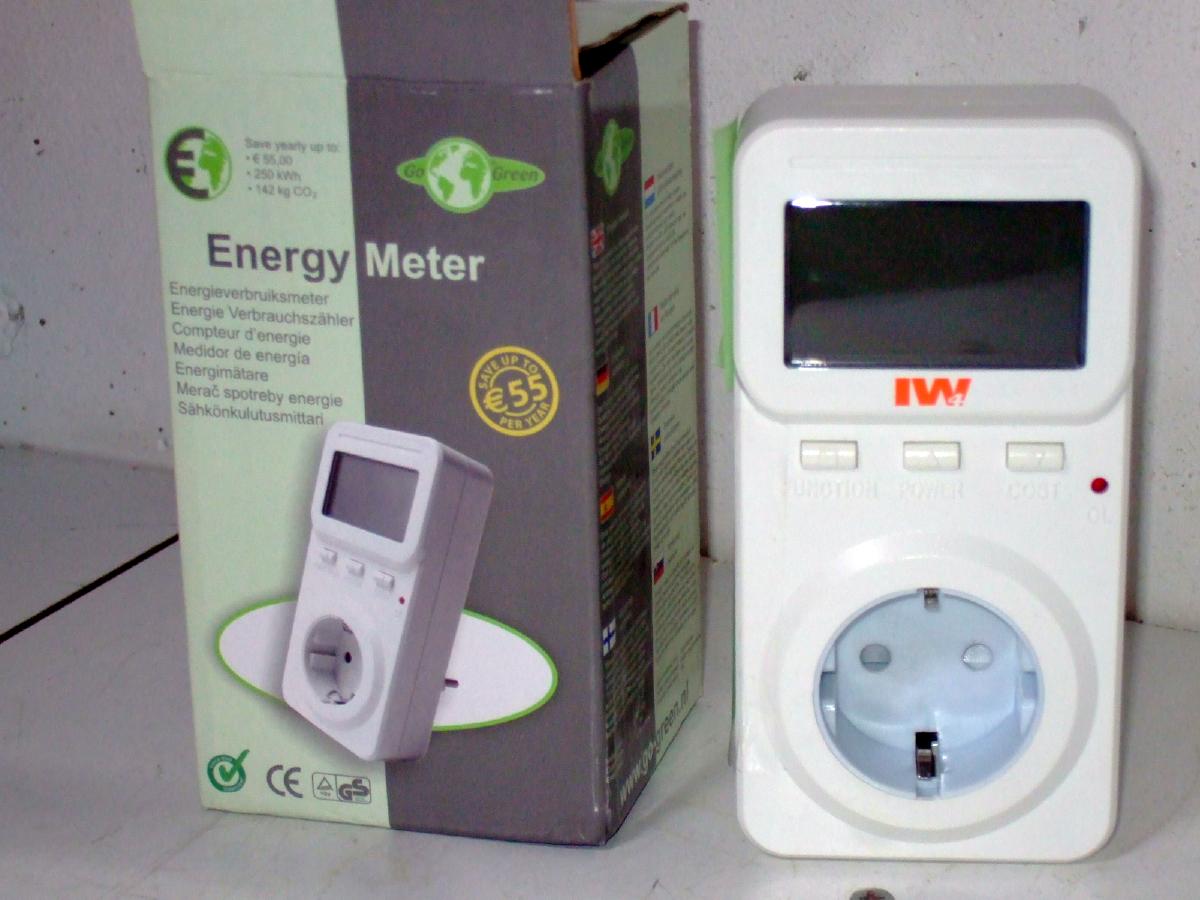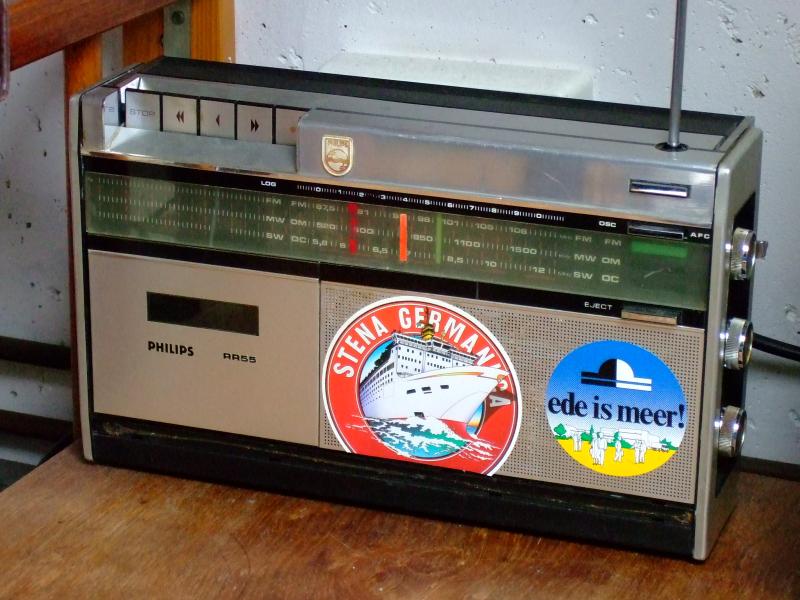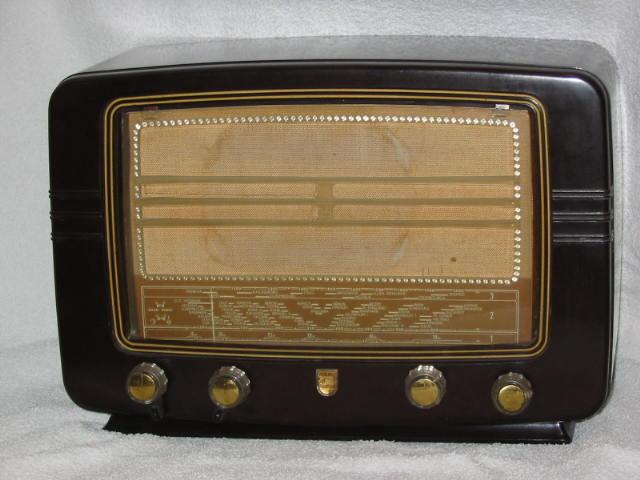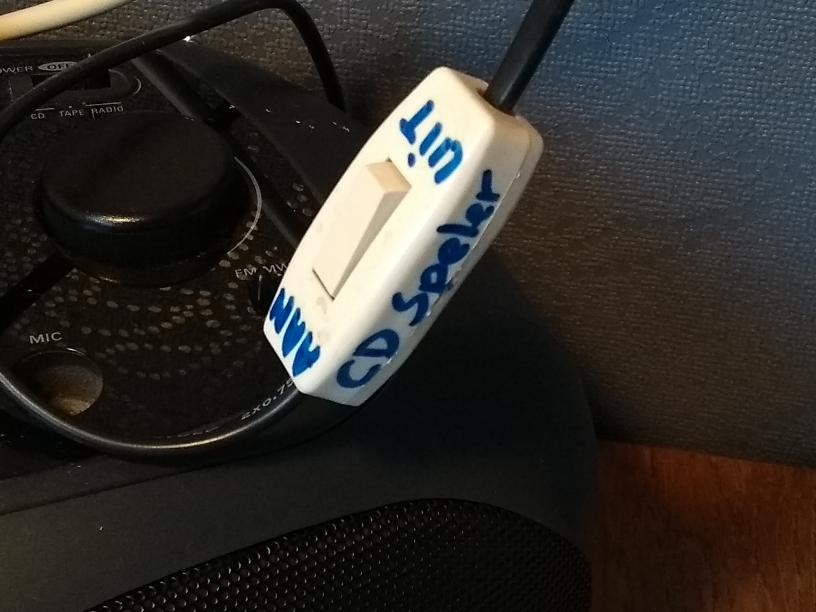
36. Vampire Power Consumption
How expensive is the possession and use of a radio collection
in terms of power consumption?
In December 2013 I did some power measurements to test my hypothesis:
that using tube radios is cheaper than using transistor radios,
because of
the vampire power.
The Measurement Equipment

 Some time ago, I got a Go-Green Power Meter IW4 at a flea market.
I used it some time to measure the yield of my solar panels
(they produce electricity for some 80 to 100 euro per annum).
The measurement on vampire power consumption were taken
on December 16, 2013.
Some time ago, I got a Go-Green Power Meter IW4 at a flea market.
I used it some time to measure the yield of my solar panels
(they produce electricity for some 80 to 100 euro per annum).
The measurement on vampire power consumption were taken
on December 16, 2013.
Because current may be out of phase with voltage,
I wanted to verify that the meter takes this into account,
and does not simply measure current.
I connected a 100nF capacitor and found the meter read 0.0,
which is the correct value for a capacitor.
The impedance of the cap at 50Hz is 31.8kOhm,
at 220V it passes a current of 6.9mA,
so the product of voltage and current is 1.5W.
Clearly, the meter has recognised that current and voltage
are out of phase, and no power is actually consumed.
Of course, I still realise that the measurement precision,
certainly for a consumer product like this,
is limited.
Yet, I assume that where my meter reads 0.0W,
the true power consumption is very low,
probably below 0.1, certainly below 0.2W.
Let the measurements begin!
Transistor Radios
The table on the right shows measurements
on mains powered transistor equipment.
Most transistor radios (that are battery plus mains)
have the power switch in the DC circuit,
so when switched off,
the power supply is still connected to the mains
and continues to draw some vampire power.
How expensive is this?
The average year has 8766 hours,
so each 1W continuous draw means 8.77kWh per year,
at a price of 24ct this costs 2.10€.
So, sitting the two Grundigs in your room, plugged but never used,
sets you back some 6€ per year!
(The exploding energy prices in 2022 increase
the cost of a Vampire Watt to 4 to 8 euro's per year.)
To make this argumentation more accessible,
I wrote a small Excel sheet called
StroomCalc.
In the top, fill out your electricity price,
for how many days you want to compute the cost,
and how many hours per day you will use your radio.
Lower down, you can fill out for five radio's
the power consumption when On and when Off,
and read the electricity cost for your period.
Some additional observations.
For some radios the mode of operation makes a difference,
but not very much.
The Grundig Satellite consumes 3.2W on AM and 3.7W on FM.
Because transistor radios have class B output stages,
power consumption increases with volume.
Cranked up to neighbor-annoying level,
the Satellit 2100 takes 5.5W.
The reported measurements were all taken with the volume down low.
 The star of the day was of course, unexpectedly,
the Philips RR55 cassette radio.
Here there are probably switches in the main circuit,
shutting down all vampires completely when you switch off the set.
Very good for Philips and very sustainable for 1972.
A pity the thing is so ugly, and we never play cassettes.
The star of the day was of course, unexpectedly,
the Philips RR55 cassette radio.
Here there are probably switches in the main circuit,
shutting down all vampires completely when you switch off the set.
Very good for Philips and very sustainable for 1972.
A pity the thing is so ugly, and we never play cassettes.
By the table, vampire draws between 1 and 2 Watt
are typical for big portables,
and up to 1W for smaller portables.
The N2511 performs nice also, no vampire at all,
but this is in fact a hifi piece,
unable to operate from battery, with AC switched power.
The Akai ABD10 is a more modern set,
which is DC switched,
but comes with a modern switched mode power supply.
I bought the Senfor in 1999 for 7€, which is cheap,
and left it plugged.
Since 1999 it cost me 47€ of power!
I unplugged it after the measurements and calculations.
Tube Radios
After switching a tube radio on,
there is a power peak, then power decreases and then it increases again.
The first power peak is the draw of cold filaments/heaters.
When they warm up, their resistance increases and the current decreases.
A few seconds later, the catodes become hot enough to make
a B-current flow.
Within about a minute, the power reaches the level reported in the last column.
I found the power to be a little lower than the power specified for the set,
in almost all cases.
My hypothesis is that this is because of the aging of the tubes.
Tube radios have class A output stages,
and the power is hardly influenced by playing volume.
 There is an influence of tuning, but small.
Tuning a strong transmitter reduces the current of the RF tubes
(by the Automatic Gain Control AGC), which reduces the power
by about 0.5 to 1W.
The Philips BX321, for example, draws 41.3 when tuned,
and 42.2 when not tuned to a station.
The reported power is when tuned to a station.
There is an influence of tuning, but small.
Tuning a strong transmitter reduces the current of the RF tubes
(by the Automatic Gain Control AGC), which reduces the power
by about 0.5 to 1W.
The Philips BX321, for example, draws 41.3 when tuned,
and 42.2 when not tuned to a station.
The reported power is when tuned to a station.
There is quite an influence of line voltage.
The Standard 430 uses 35W at 208V, and 41W at 228V.
The reported power consumptions are for 228V line voltage.
Household Appliances
Appliances Measurements
| Apparatus |
Standby |
In use |
|---|
| Amplifier |
1.2 | 20 |
| Modem |
| 12 |
| TV (flat screen) |
0.6 | 180-200 |
| Laptop |
0.5 | 25 |
Modern switched mode power supplies
are better in reducing vampire load.
I measured an iPad adaptor, without the iPad, to use 0.0W.
The power supply of my TV is good,
because it can deliver 200W when showing white screens,
but takes only 0.6W in stand-by mode.
The surge of my modem is a bit worrying;
and I should not forget to switch of my music amplifier at night.
Reducing Vampire Cost
The vampire draw of transistor radios is serious,
and for the good of your wallet and the planet,
you should not ignore it!
As you can notice, the cost per apparatus is quite low;
the total cost can be high because of a large number
of these small leaks in your household.
Your Wattmeter is your friend!
You can use it to actually measure power consumption
of your equipment,
not only when ON (a figure often found in the manual),
but more importantly, when switched OFF.
If you don't have a Wattmeter,
the figures mentioned in this article may give a ballpark.
And whatever becomes warm, consumes power:
if the external power supply of your keyboard
is warmer than its environment,
it's probably transformer-based.
Use AC-switched equipment:
If you want to have a radio in some place and use it rarely,
surprisingly,
a tubed set may be the wisest choice energywise.
Depending on the power consumption of your tube set,
and the vampire consumption of your transistor set,
the trade off is around a use
of half an hour to one hour per day.
To compute the trade off,
you'll need to measure the consumption of course,
and do some calculations.
 Move to AC-switching:
If you have a display with several transistor radios plugged in,
consider to install a power switch
that switches off the entire display
when the sets are not used.
For DC-switched radio's, install a socket switch
and train yourself to use it instead of the built in DC switch.
The cost of this measure is around 2 euro's,
and installation time is like ten seconds.
With a pay back period in the range of one to two years,
this is one of the most extremely efficient power saving measures.
Move to AC-switching:
If you have a display with several transistor radios plugged in,
consider to install a power switch
that switches off the entire display
when the sets are not used.
For DC-switched radio's, install a socket switch
and train yourself to use it instead of the built in DC switch.
The cost of this measure is around 2 euro's,
and installation time is like ten seconds.
With a pay back period in the range of one to two years,
this is one of the most extremely efficient power saving measures.
 My thrift shop offers a box of used in-line switches for 50ct;
installing such a switch takes a few minutes,
but you can do it at any convenient place in the chord,
and pay back period is then under half a year.
For example, my Philips AZ8052 in the guest room
consumes 1,9W when off,
which means about 4 euro's per year,
or 50ct in one and a half month.
My thrift shop offers a box of used in-line switches for 50ct;
installing such a switch takes a few minutes,
but you can do it at any convenient place in the chord,
and pay back period is then under half a year.
For example, my Philips AZ8052 in the guest room
consumes 1,9W when off,
which means about 4 euro's per year,
or 50ct in one and a half month.
Pulling the power plug is an even cheaper,
but perhaps less convenient way of AC interruption.
Use modern power supplies:
Instead of using the built-in, transformer-based power supply,
attach an external switched-mode supply.
Switched power converters are not only
more efficient under normal working load,
but more importantly,
they are much better without DC load.
A USB charger for an iPad, for example,
shows 0.0W on the meter when no iPad (or radio) is connected.
 Battery equipment can always be used
with a supply voltage slightly below battery voltage.
This is because the manufacturer wants you to use
your batteries even when the voltage has decreased al little bit.
As a rule of thumb, 70% of the nominal battery voltage
is sufficient for an acceptable operation of the radio.
For a radio supplied by four monocells,
this implies that a 5V USB charger can be used.
So, cut off the small plug from a USB cable,
and connect the appropriate wires to the battery contacts.
The radio can now be powered from a USB charger.
Battery equipment can always be used
with a supply voltage slightly below battery voltage.
This is because the manufacturer wants you to use
your batteries even when the voltage has decreased al little bit.
As a rule of thumb, 70% of the nominal battery voltage
is sufficient for an acceptable operation of the radio.
For a radio supplied by four monocells,
this implies that a 5V USB charger can be used.
So, cut off the small plug from a USB cable,
and connect the appropriate wires to the battery contacts.
The radio can now be powered from a USB charger.
| Philips D2130 |
| Supply |
Intern |
USB |
| OFF |
0.7W |
0.0W |
| AM |
0.8W |
0.2W |
| FM |
1.0W |
0.3W |
The resulting power decrease implies a saving of 1 to 1.5 euro's per annum.
There is a slight, but noticable performance degradation,
resulting from the lower voltage and from the switching in the supply.
The switching may induce interference when listening
to weak AM stations.
The lower voltage may reduce FM sensitivity,
so pulling out the antenna may be needed.
The lower power reduces the maximal output power.
Of course, instead of using a USB 5V supply,
you can buy a new power supply (cost about 2 euro's)
of the exact correct voltage.
Buy new stuff:
New equipment uses less energy!
See vampire power
to read about the One Watt Initiative.
This old TV from the thrift shop may look attractive
as an extra set in your guest room,
but might also set you back 15 euro's per year.
The transition from AM to FM, or from FM to DAB,
is a nice opportunity to treat yourself
to a fresh, energy efficient radio.
Gerard Tel.
 The star of the day was of course, unexpectedly,
the Philips RR55 cassette radio.
Here there are probably switches in the main circuit,
shutting down all vampires completely when you switch off the set.
Very good for Philips and very sustainable for 1972.
A pity the thing is so ugly, and we never play cassettes.
The star of the day was of course, unexpectedly,
the Philips RR55 cassette radio.
Here there are probably switches in the main circuit,
shutting down all vampires completely when you switch off the set.
Very good for Philips and very sustainable for 1972.
A pity the thing is so ugly, and we never play cassettes.


 Some time ago, I got a Go-Green Power Meter IW4 at a flea market.
I used it some time to measure the yield of my solar panels
(they produce electricity for some 80 to 100 euro per annum).
The measurement on vampire power consumption were taken
on December 16, 2013.
Some time ago, I got a Go-Green Power Meter IW4 at a flea market.
I used it some time to measure the yield of my solar panels
(they produce electricity for some 80 to 100 euro per annum).
The measurement on vampire power consumption were taken
on December 16, 2013.
 There is an influence of tuning, but small.
Tuning a strong transmitter reduces the current of the RF tubes
(by the Automatic Gain Control AGC), which reduces the power
by about 0.5 to 1W.
The Philips BX321, for example, draws 41.3 when tuned,
and 42.2 when not tuned to a station.
The reported power is when tuned to a station.
There is an influence of tuning, but small.
Tuning a strong transmitter reduces the current of the RF tubes
(by the Automatic Gain Control AGC), which reduces the power
by about 0.5 to 1W.
The Philips BX321, for example, draws 41.3 when tuned,
and 42.2 when not tuned to a station.
The reported power is when tuned to a station.
 Move to AC-switching:
If you have a display with several transistor radios plugged in,
consider to install a power switch
that switches off the entire display
when the sets are not used.
For DC-switched radio's, install a socket switch
and train yourself to use it instead of the built in DC switch.
The cost of this measure is around 2 euro's,
and installation time is like ten seconds.
With a pay back period in the range of one to two years,
this is one of the most extremely efficient power saving measures.
Move to AC-switching:
If you have a display with several transistor radios plugged in,
consider to install a power switch
that switches off the entire display
when the sets are not used.
For DC-switched radio's, install a socket switch
and train yourself to use it instead of the built in DC switch.
The cost of this measure is around 2 euro's,
and installation time is like ten seconds.
With a pay back period in the range of one to two years,
this is one of the most extremely efficient power saving measures.
 My thrift shop offers a box of used in-line switches for 50ct;
installing such a switch takes a few minutes,
but you can do it at any convenient place in the chord,
and pay back period is then under half a year.
For example, my Philips AZ8052 in the guest room
consumes 1,9W when off,
which means about 4 euro's per year,
or 50ct in one and a half month.
My thrift shop offers a box of used in-line switches for 50ct;
installing such a switch takes a few minutes,
but you can do it at any convenient place in the chord,
and pay back period is then under half a year.
For example, my Philips AZ8052 in the guest room
consumes 1,9W when off,
which means about 4 euro's per year,
or 50ct in one and a half month.  Battery equipment can always be used
with a supply voltage slightly below battery voltage.
This is because the manufacturer wants you to use
your batteries even when the voltage has decreased al little bit.
As a rule of thumb, 70% of the nominal battery voltage
is sufficient for an acceptable operation of the radio.
For a radio supplied by four monocells,
this implies that a 5V USB charger can be used.
So, cut off the small plug from a USB cable,
and connect the appropriate wires to the battery contacts.
The radio can now be powered from a USB charger.
Battery equipment can always be used
with a supply voltage slightly below battery voltage.
This is because the manufacturer wants you to use
your batteries even when the voltage has decreased al little bit.
As a rule of thumb, 70% of the nominal battery voltage
is sufficient for an acceptable operation of the radio.
For a radio supplied by four monocells,
this implies that a 5V USB charger can be used.
So, cut off the small plug from a USB cable,
and connect the appropriate wires to the battery contacts.
The radio can now be powered from a USB charger.